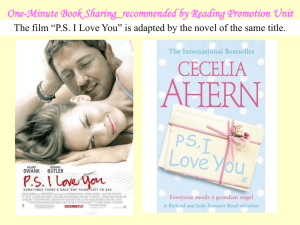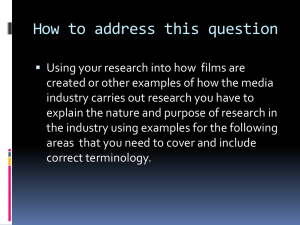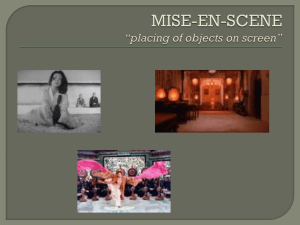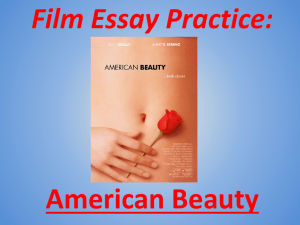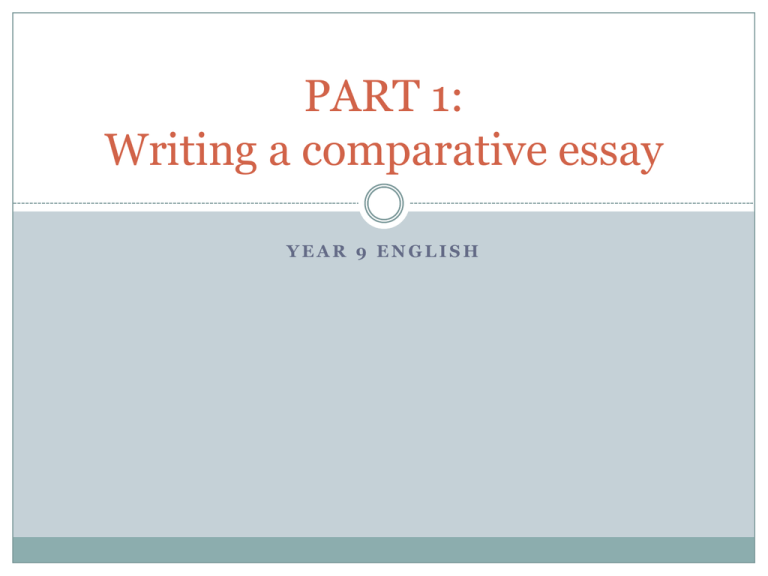
PART 1:
Writing a comparative essay
YEAR 9 ENGLISH
What is a compare and contrast essay?
You are to compare and contrast two pieces of text
(………………………………..) and discuss the similarities and
differences between them.
The director has made choices about what scenes and characters are
important and how this is to be conveyed to an audience.
Your job is to identify (find out) what has changed from the original
novel.
What are some of the similarities between the way the characters
were portrayed in the film and the novel?
What were the differences in setting?
What are the differences between the plot in film and the novel?
What are some of the similarities between the dialogue used in the
film and the novel?
Planning
Read the book and take note of the plot, the description of
characters, the setting.
Decide on a particular section of the film/story that you would
like to concentrate on analysing.
Re-read the equivalent section of the novel and take clear
notes about how the author used language to make meaning
or get his point across.
Review the section of the film you have decided to concentrate
on. Pay particular attention to the ways in which the director
has used VISUAL elements to make meaning.
Write specific notes about the similarities, differences,
additions and omissions (what has been left out) between the
two versions.
Use this table to plan your work
Aspect 1
Aspect 2
Aspect 3
Is is about
the setting,
character or
dialogue
(language) ?
Film
Novel
For each of the ‘aspects’ becomes a paragraph in your main essay. Each
paragraph discusses one aspect of the texts and compares and contrasts its
depiction.
Writing the essay
The introduction
Identifies which two texts are going to be compared
for the purposes of the task.
Acknowledges that one text is an interpretation of
another and not a reproduction.
Makes a comment about how close the adaptation
(the film) is to the original text (the novel).
Example 1
John Marsden’s novel, Tomorrow, When the War Began, explores
the harshness of life for young teenagers thrust in to threatening
experiences, explores the consequences of war in a small country
town and questions the moral codes of life and death. The film
adaptation of the novel presents a new representation of the text. It
provides a visual depiction of Wirrawee and the events and
characters in the text. Specifically, it uses lighting and special effects
to illustrate the bridge destruction scene . In addition, the film is
presented through a range of characters perspectives, not just Ellie’s
insights as demonstrated in the novel. Despite these key differences,
the film stays faithful to the original text, but does make alterations
to the relationship shared between Ellie and Lee.
What is good about this response?
What is not so good about this response?
Example 2
Tomorrow When the War began is kind of like the
book. It is a good version of the book but there are
differences between the book and the film too. The
character Ellie is different because she looks
different. In conclusion, The film is a bit like the
book but not really
The body paragraphs
One main idea per paragraph. (Go back to your table,
each of your main aspects should be used as an idea
for a paragraph).
Explore how the aspect is depicted (shown) in the
novel.
Use supporting evidence (quotes) to show how the
LANGUAGE has changed from the novel to the film.
Draw attention to the similarities and differences in
the depiction of the scene/character/setting between
the novel and film.
Remember to leave a line between each paragraph.
Example 1
The depiction of Ellie in the film adaptation is not true to
Marsden’s vision. Throughout the novel, Ellie is shown to be a
brave young girl. “I made myself leave the darkness and go to
it, in four quick light steps, a dance that surprised me…it was
a dance of courage.” (pg 81). Indeed, Ellie is shown to be the
leader of the group, the person prepared to make hard
choices. This is particularly true in the novel, when Ellie
convinces Fi to break in to the petrol station and steal a petrol
tanker that is used to blow up the bridge. However, in the
film, Ellie is depicted as unwilling to take control of her life.
The producer emphasises Ellie’s vulnerability through the use
of extreme close ups on her face; the audience sees her crying
and visibly upset. In this way, the portrayal of Ellie in the film
and novel are starkly different.
Example 2
there are a few similarities and differences between
how Ellie is shown in the film and the novel. In the
book she is often cranky and does not co-operate
with the group but she is still very strong and gets
her own way most of the time even when the bridge
gets blown up which is a massive scene and n the
movie she is shown as not very motiated and she is
crying all of the time which shows us that she is sad
at what is happening in her life. This is one of the
differences between the film and the book.
Conclusion
Do not introduce new ideas.
Make general comments about how realistic the film
was.
Example 1
Their are a range of differences between John
Marsdens novel ‘Tomorrow, When the War Began’
and it’s film adaptation, specifically in the depiction
of the character ‘Ellie’, the setting of the bridge scene
and the language used in the film and the descriptive
metaphors used in the novel. Ultimately the film
offers a visual illustration of the physical, emotional
and moral consequences of war through realistic
dramatisation of violence, fighting and abuse and it’s
catastrofic effects
Example 2
the film was pretty good because you don’t have to
read, instead you just watch it. The character, Ellie,
shows the audiece that a girl can be a strong
character that stands up for herself when faced with
terrifying events like war. However, the film does
share some similarities with the novel, especially in
the setting of the town. The end.
Checklist for the introduction
Things to do in the
INTRODUCTION
Things NOT do in the
INTRODUCTION
*
*
*
*
*
*
Based on the examples for the paragraphs, write what you should do and
should not do in the introduction, main body and conclusion.
Checklist for the main paragraphs
Things to do when writing my
MAIN paragraph
Things NOT do when writing my
MAIN paragraph
*
*
*
*
*
*
Checklist for the conclusion
Things to do when writing the
CONCLUSION
Things NOT do when writing my
CONCLUSION
*
*
*
*
*
*
PART 2: Oral presentation
You will need to prepare a 2 minute oral
presentation on a review of the film.
You will need to talk about the strengths and
weaknesses of the film compared to the book.
You will need to refer to at least 2 scenes from the
film and compare them to the novel.
Use the following questions to guide your
presentation:
Questions for the oral presentation
Remembering:
Describe a key scene in the novel. Explain why you like it.
Understanding:
What do you think are some of the main ideas raised in the film? How did the film
makers use music and special effects? How did these help the story?
Applying:
What do you think John Marsden would say about the film adaptation of his novel?
Analysing:
Did the actors perform well? What made it a good performance?
Evaluating:
Do you think war is a good or a bad thing? Why? Why not? What influence will war
have on our lives?
Creating:
If you were a film maker, what would you change in the film? How effective was the
film in discussing some of the main ideas in the novel?
You could also do a P,N,I on the film.
Due dates
The comparative essay is due on Thursday 16th June.
You will have 3 periods in class to work on this.
The oral presentations will take place on Thursday
23rd June. You will have 2 periods in class to work on
this task.
If you do not think you will be able to finish the work
by these dates speak to me BEFORE the work is due.


